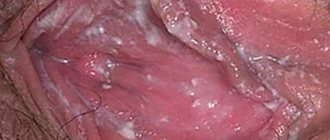Colpitis often develops in women during pregnancy. The disease is diagnosed in 75-80% of cases. The likelihood of developing inflammation does not depend on the duration of pregnancy. The high risk of infection persists throughout the entire period of gestation. The greatest danger to the unborn child is posed by a disease that occurs in the third trimester of pregnancy.
Colpitis during pregnancy due to weakened immunity is much more severe, and therefore poses a threat to the normal development of the fetus.
Toxins released by pathogenic and opportunistic microorganisms cause inflammation that affects the uterus and birth canal. A child can get a “bad” disease not only in the womb, but also during delivery. The consequences of infectious infection are manifested by allergies, encephalopathy, and in the woman herself - endometritis, secondary infertility.
Causes of colpitis during pregnancy
The infection easily penetrates the mother's body, all of whose immune mechanisms are aimed at maintaining the life and development of the fetus. Due to hormonal changes, an alkaline environment is formed in the vagina, favorable for the proliferation and colonization of bacteria.
Predisposing factors to the development of infectious vaginitis in expectant mothers:
- early onset of sexual activity (14-16 years);
- chronic STIs;
- promiscuity;
- trauma to the vaginal mucosa (as a result of rough sex, medical procedures, surgical treatment);
- long-term antibiotic therapy.
If a woman leads a healthy lifestyle, lives with one partner, maintains intimate hygiene, and undergoes routine examinations with a gynecologist, then the risk of developing colpitis during pregnancy is minimal.
Any discomfort in the vagina, discomfort during sexual intercourse, or discharge should be a reason for a comprehensive diagnosis.
What is included in the examination for colpitis during pregnancy?
Causes of vaginosis, vaginitis and thrush
All three diseases are united by the fact that not only unprotected sexual intercourse can provoke the development of infection). The disease is also often associated with changes in hormonal levels, decreased immunity, and other reasons.
The essence of the process is this: every woman who has reached puberty has a unique microflora composition. It is not constant - the bioflora is formed by various factors, including ovulation, ARVI, stress, taking hormonal contraceptives, wearing tight-fitting trousers made of thick fabric, etc. All these processes cause a change in the conditions necessary for the life of certain bacteria. For example, when wearing synthetic panties, air access to the genitals is stopped, and the air temperature and humidity increase. As a result, anaerobic (air-hungry) beneficial bacteria die, and bacteria such as candida develop rapidly.
Getting thrush in an hour of being in a wet swimsuit in the sun is a piece of cake.
The microflora of a healthy woman is dominated by beneficial lactic acid bacteria (lacto- and bifidobacteria). When the quantitative and qualitative composition of the microflora shifts, beneficial bacteria give way to pathogenic anaerobic (able to live in the absence of oxygen) and facultative anaerobic (which oxygen does not have a destructive effect on).
The natural acidity level of 3.8-4.2 pH increases, and therefore lactic acid bacteria die (disintegrate), releasing ammonia. This is why vaginitis and vaginosis are characterized by an unpleasant smell of discharge.
Colpitis (vaginitis) most often occurs due to infection with an STD. This distinguishes it from vaginosis and thrush. Candidiasis (thrush) occurs without sexual intercourse. It is quite possible to pick it up in a pool or sauna if you sit on a bench without a towel. Thrush manifests itself when wearing neoprene shorts during fitness classes, tight-fitting trousers made of thick fabric, or playing sports in clothes not intended for this purpose. This disease worsens during adolescence, when rapid hormonal changes occur. It is rare that candidiasis is transmitted directly through sexual contact.
Symptoms of colpitis in pregnant women
Symptoms of colpitis differ depending on the type of pathogen and the stage of the disease. In the acute form, the clinical manifestations of the infection are pronounced, in the chronic form they are hidden, felt only during periods of relapse.
| Type of disease | Type of pathogen | Symptoms |
| Nonspecific colpitis | ||
| Candidiasis (thrush) | Candida fungus | Curdled white discharge, unbearable itching, redness of the genitals |
| Bacterial | Gardnerella, Escherichia coli, Proteus | Mucus discharge with an unpleasant odor, pain in the lower abdomen |
| Viral | Herpes, HPV | Foamy, foul-smelling discharge, erosions or “warts” on the vaginal mucosa |
| Specific colpitis | ||
| Gonorrhea | Gonococci | Discharge with pus, discomfort and pain in the vaginal area, pain during intercourse |
| Chlamydia | Chlamydia | Thick milky discharge, burning sensation in the vagina |
| Trichomoniasis | Trichomonas | Discharge with the smell of rotten fish, burning and pain when urinating |
The problem is that colpitis during pregnancy is caused not by one, but by several infectious agents. When examining a vaginal smear, an association of microorganisms is revealed, and in some of them, for example, in Candida fungi, more dangerous, pathogenic bacteria - ureaplasma and mycoplasma - can exist latently. In the early stages, this form of vaginitis is very dangerous for the child: hidden infections can cause miscarriage and affect the formation of the nervous system.
Clinic depending on the form of colpitis
In the acute form, the listed symptoms are noticeable for a long time and do not go away on their own. In addition to discharge with an unpleasant odor, the pregnant woman experiences discomfort when walking, constant burning and itching not only in the vagina, but also in the area of the inner thighs and buttocks.
In the chronic course of colpitis, the clinical signs are blurred, but even with a mild cold, a relapse can occur. The infection makes itself felt by redness of the genitals and scanty yellowish discharge.
Diagnostics
The doctor can make a preliminary diagnosis of “Colpitis” immediately after listening to the patient’s complaints and examining her in a chair, during which a strong inflammatory process is revealed. The only difficulty is that it is necessary not only to identify the disease, but also to understand its cause. Very often, colpitis accompanies other gynecological diseases and is a consequence of disturbances in the functioning of certain systems and organs.
Collecting information if colpitis is suspected involves the following procedures:
- Ultrasound of the pelvis;
- standard gynecological examination using speculum;
- colposcopy (examination of the vagina using a microscope);
- rectal examination (digital/visual inspection of the rectum for fistulas);
- amiotest (aimed at determining a specific odor);
- bacteriological and cytological analyses;
- blood test (general, biochemical, hormones);
- Analysis of urine.
The gynecologist faces the following tasks:
- determine the exact boundaries of the emerging inflammatory process;
- exclude the presence of inflammation in the uterus, its appendages and cervix;
- identify the pathogen (if we are talking about infectious colpitis);
- analyze dysbacteriosis;
- check the level of estrogen in the blood;
- determine which antibiotics microbes are resistant to;
- check for structural changes in the vaginal mucosa,
- detect chronic diseases that may affect the course of colpitis.
Treatment methods for colpitis in expectant mothers
Treatment of the disease during pregnancy is somewhat difficult. The main method of destroying infectious agents is antibiotic therapy. Most antibacterial drugs have side effects on the fetus. Long-term use of antibiotics provokes the addiction of pathogenic microorganisms and the further spread of infection.
When choosing treatment tactics, the doctor’s primary task is not to harm the child, so the safest combination of medications is selected. If the disease is mild, then local procedures and medications are limited. You can make vaginal baths with medicinal herbs (chamomile, oak bark, calendula), put candles at night, for example, Terzhinan.
Systemic therapy
In the acute form, systemic therapy is carried out, aimed not only at destroying foreign microflora, but also at normalizing the protective environment of the vagina, eliminating pain, and relieving discomfort associated with inflammation of the genital organs.
The standard course during pregnancy is prescribed only from the 2nd trimester and includes several types of drugs:
- antifungal (for thrush) - Nystatin, Pimafucin;
- antiprotozoal (for trichomoniasis, chlamydia) – Metronidazole (topically);
- antibacterial (for nonspecific colpitis) – Erythromycin;
- to restore intestinal microflora - Bifidoback, Linex.
The combination of medications, dosage and duration are selected by the doctor. In this case, both partners must undergo a course of treatment for colpitis. To restore the natural microflora, it is useful for pregnant women to consume fermented milk products, eat lingonberries, and sour berries.
Read more about the treatment of colpitis during pregnancy
Composition of a smear for microflora: norm and pathology
To identify the composition of the flora, you need to take a smear from a gynecologist. A smear on the flora is taken from the urethra (U), from the cervix (C) and the vaginal wall (V).
In a healthy woman, the composition of the microflora will look like this:
- Flat epithelium
. If it lines the walls of the vagina in layers, this indicates vaginitis, because normally there should be single digits of squamous epithelial cells. If there are no squamous epithelial cells at all, this indicates atrophic vaginitis. - Leukocytes
. They are designed to neutralize the causative agent of infection, therefore they are characteristic of inflammation. White blood cells are absent only in vaginosis. - Gram-positive rods
(staining blue during the Gram test). These are lactobacilli and Dederlein bacilli, which maintain optimal alkaline balance in the vagina. They feed on glycogen, a polysaccharide that gives life to beneficial microorganisms. When glycogen breaks down, lactic acid is formed, which prevents pathogenic bacteria from multiplying. With a decrease in immunity, gram-positive bacilli are reduced in quantity and are unable to resist infections. The more gram-positive rods in the composition, the better. - Slime
. It is needed to maintain a moist environment of the vaginal mucosa. Mucus is secreted by the glands of the cervical canal. Normally, the volume of mucus secreted is equal to the amount absorbed (about 5 ml), and an increase in the norm indicates inflammation of the cervix. - Key cells
. It is a squamous epithelial cell surrounded by bacteria. This only happens when the vaginal microflora is disrupted.
Prevention of colpitis during pregnancy
To prevent colpitis, women planning pregnancy and after conception are advised to regularly visit a gynecologist and get tested for bacterial infections. Protected sex, following doctor's recommendations on nutrition and lifestyle, careful hygiene of the genital organs are measures that will help avoid conditions that are dangerous to the life of the unborn child.
To make an appointment or get advice, call the 24-hour number
+7
or fill out the form
What are the differences between the symptoms of vaginosis, vaginitis and thrush?
Let's compare the signs of colpitis, candidiasis and gardnerellosis:
| Symptoms | vaginosis | vaginitis | thrush |
| Itching and burning in the genital area | + | + | + |
| Discharge | Have an unpleasant “fishy” smell | There may be both purulent discharge and vaginal dryness | White curdled discharge |
| Redness and swelling of tissues | No | There is | There is |
| Presence of pathogenic bacteria | There is | There is | There is |
| Inflammatory process | No | There is | There is |
Treatment of vaginosis, vaginitis and candidiasis
Whether or not to treat these diseases is up to you to decide. All three pathologies may not give unpleasant signs for a long time and the woman may well come to terms with the state of affairs. Another option is to self-medicate, which, as you know, will definitely not lead to anything good.
Treatment of all three diseases is carried out with antiseptics in the form of suppositories, tablets or ointments. It is prescribed exclusively by a doctor and selected according to individual indications.
If you still made the right decision and chose treatment from a gynecologist, come to the Diana clinic in St. Petersburg. Here you can get tested inexpensively and be cured of any gynecological disease.
Comparative analysis of the results of a smear on microflora from the vagina
| Index | norm | vaginosis | vaginitis | candidiasis |
| leukocytes | 0-10 | 8-10 | over 30 | 5-100 |
| squamous epithelium | 5-10 | 5-10 | 25-40 | |
| gonococci | No | There is | a large amount (for gonorrheal vaginitis) | There is |
| key cells | No | There is | many cells surrounded by gardnerella | There is |
| yeast | No | There is | There is | over 104 CFU/ml |
| slime | moderately | above normal | a large number of | There is |
| microflora | Dederlein sticks | bacilli mobiluncus curtisii, Gardnerella vaginalis | low number of lactobacilli | Candida albicans |
| pH | 3,5-4,5 | 5-6,5 | 4-6 | 4-5 |








